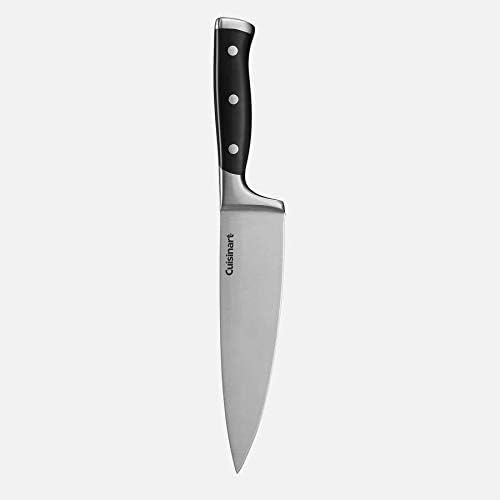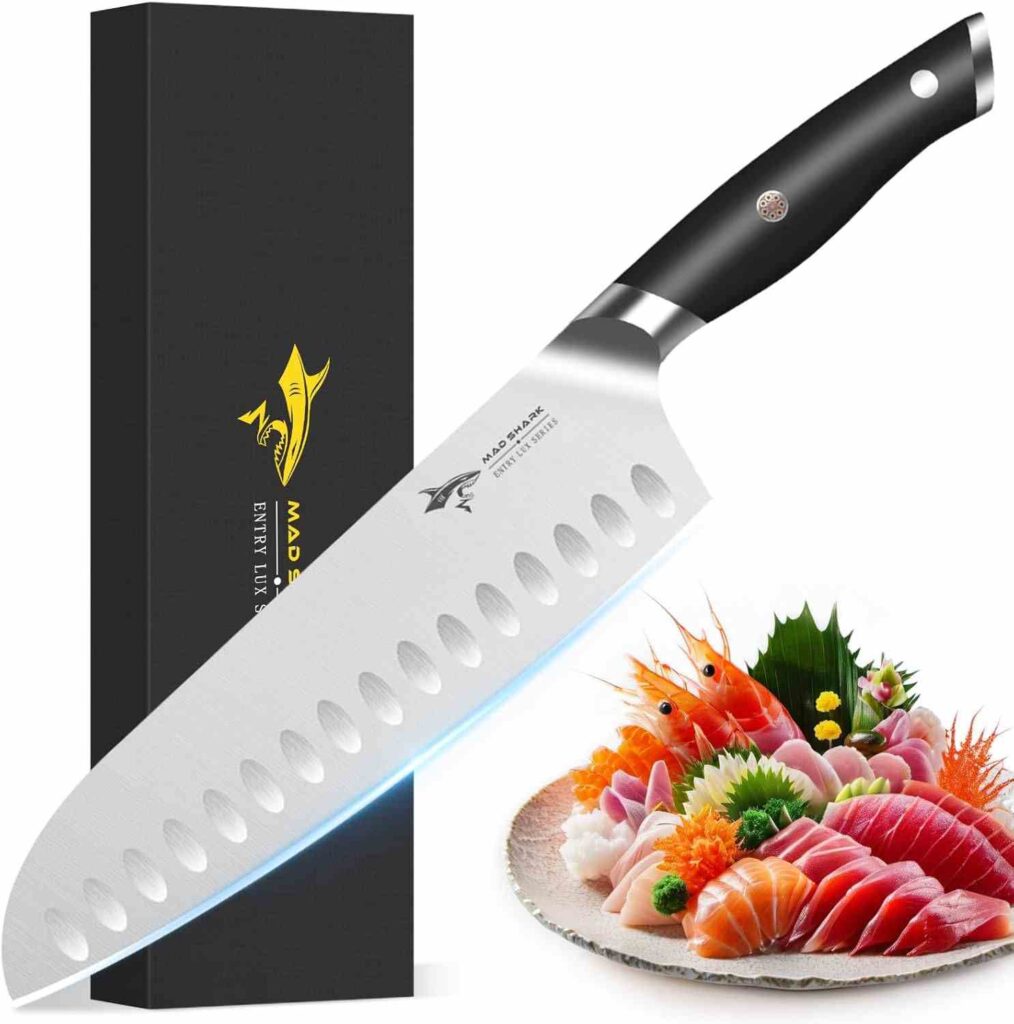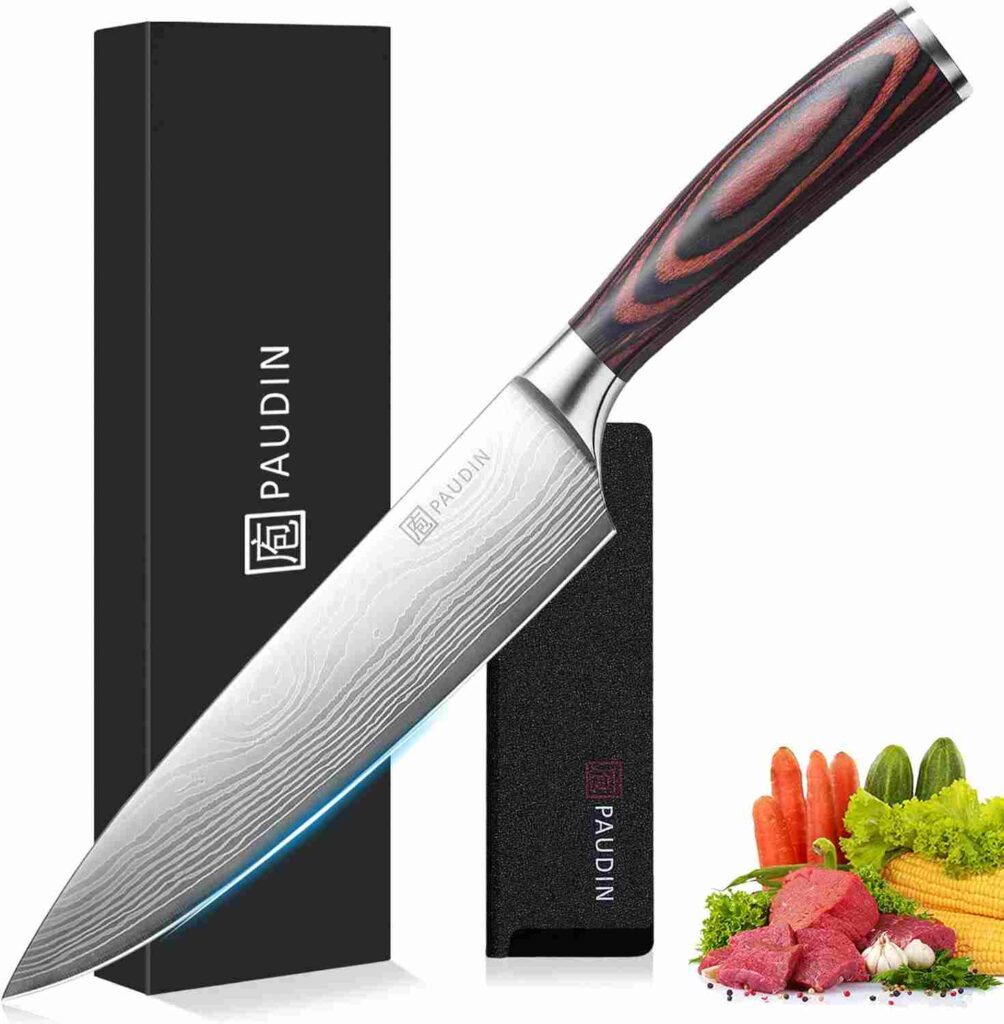Published on August 1, 2025 by Filip
Last updated on September 3, 2025

Kitchen knives don’t need to cost a fortune to deliver pro-level results, as showcased in my testing of the best chef knife under $50. Once you hit the $50 mark, you will start witnessing a real jump in quality with sharper blades, better steel, and excellent ergonomics. In my opinion, this is the perfect price point for any home chef. You don’t need to spend more.
I tested several budget-friendly chef knives in this range and found a few standout performers that punch above their price tag. Whether you’re dicing vegetables for the week or dealing with tougher meal prep, these chef knives under 50 are well-balanced and built for the long-haul.
Quick Picks: Top 3 Chef Knives Under $50
| Knife | Weight | Material | Verdict | Price |
|---|---|---|---|---|
| Cuisinart C77TR-CF-25 Chef Knife | ~7.5 oz | High-Carbon Stainless | Best Entry-Level Forged Knife | View on Amazon |
| MAD SHARK Professional Santoku Knife | ~6.9 oz | German High-Carbon Steel | Best Grip & Precision | View on Amazon |
| PAUDIN 8” Chef Knife | ~7.1 oz | 5Cr15Mov Stainless | Best All-Around Performance | View on Amazon |
What to Expect From a Chef Knife Under $50
This price point is the sweet spot for home cooks. That’s because you no longer have to deal with flimsy steel, or wobbly handles. On the other hand, you’re not paying extra for influencer branding and flashy packaging.
This is what actually matters in this tier:
- Blade Material: Look for high-carbon stainless or German steel. These alloys hold an edge for noticably longer. They also resist rust much better, and they are quite easy to sharpen once the time comes.
- Full-Tang Construction: A true full tang is where the blade steel runs through its entire handle, which adds durability and balance.
- Ergonomics: A good budget chef knife in this price range should feel like an extension of your hand. I prioritized non-slip, contoured handles that stay comfortable during long chopping sessions.
- Sharpen-ability: At this tier, you want a blade that reacts well to sharpening with a basic pull-through tool or whetstone. A sharp blade is a safe blade, as I outline in my piece myth-busting top 5 chef knife myths.
In-Depth Reviews: Best Chef Knives Under $50
Have a look at my in-depth looks and personal experiences while using these knives, and the reasons I recommend them.
Disclaimer: Product images shown are temporary placeholders. Once approved for the Amazon Associates Program, I will replace them with official Amazon images. As an Amazon Associate, I may earn from qualifying purchases made through affiliate links on this page.
1. Cuisinart C77TR-CF-25 Triple Rivet 8” Chef Knife

Specs:
- Blade Length: 8 inches
- Weight: ~7.5 oz
- Steel Type: High-Carbon Stainless
- Tang: Full Tang
- Handle: Triple rivet, ergonomic polymer
Pros:
✅ Forged, not stamped. It feels premium in your hand
✅ Full tang construction with a sturdy handle
✅ Sharp out of the box with a clean taper grind
✅ Dishwasher safe (but hand-washing recommended)
Cons:
👎 Handle may feel chunky for small hands
👎 Basic finish – not flashy, but functional
Let me get this out of the way first: This knife costs around $20. Prices are subject to change, so check for yourself for an updated cost, but it generally doesn’t go over $25. Why I chose it? This knife surprised me – in the best way possible.
At a remarkable price point, the Cuisianrt C77TR delivers a forged, full-tang blade with a secure and balanced feel.
In my testing, it sliced through onions, cucumbers, and chicken – with zero hesitation. The knife’s wide bolster provides excellent control while doing tougher prep with things like sweet potatoes.
It’s a workhorse knife that doesn’t pretend to be fancy, a definition for a knife punching above its weight. If you’re looking for more around this price range, have a look at my top picks under $30 – they deliver similar performance at an almost double-lower cost.
2. MAD SHARK Professional 8-Inch Santoku Knife

Specs:
- Blade Length: 8 inches
- Weight: ~6.9 oz
- Steel Type: German High Carbon Stainless Steel
- Tang: Full Tang
- Handle: Ergonomic ABS with textured grip (non-slip)
Pros:
✅ Hollow-edge Santoku blade that glides through food
✅ Excellent anti-stick coat and food release
✅ Grippy handle works well when wet
✅ Comes in a sleek gift box with a blade cover
Cons:
👎 Santoku blade limits rocking motion
👎 Not ideal for super dense bones or frozen food
The MAD Shark 8″ Santoku is the epitome of a top-performing kitchen knife under $50. It looks outstanding – like a $150+ knife – and it feels lightweight. This knife cuts cleanly and does half the work for you, though it helps to master knife techniques to take full advantage of it. The blade features a hollow edge (the little dimples you see), which reduces any drag and keeps your food from sticking. This is something that made a real difference while I was slicing through vegetables and cheese blocks.
What also stood out to me was its ergonomic handle. It is molded for comfort and balance, boasting just enough weight at its heel in order to maintain control. If you’re operating with wet or greasy hands, it’s unlikely this knife will slip your hands. What’s more, the MAD Shark is ideal if you prefer a push-cut style over a rocking motion, and it’s generally a great pick for anyone looking for more finesse rather than brute force.
3. PAUDIN 8-Inch Chef Knife

Specs:
- Blade Length: 8 inches
- Weight: ~7.1 oz
- Steel Type: 5Cr15Mov High Carbon Stainless Steel
- Tang: Full Tang
- Handle: Wood-look polymer (ergonomic)
Pros:
✅ Ultra-sharp 2mm blade with a clean taper
✅ Great weight distribution and control
✅ Sleek design with subtle waved pattern
✅ Excellent for both meat and vegetables
Cons:
👎 Not real Damascus (just patterned)
👎 Woodgrain handle is synthetic, not natural wood
This is yet another contender that positively surprised me with how it punches above its price range – in terms of look, feel, and usability. The moment you unbox it, you feel its premium aura, featuring a polished finish, sleek wave pattern (it’s not real Damascus, but it looks nice nonetheless), and its smooth, contoured handle that fits like a glove.
Where this PAUDIN really delivers is the daily performance. I ran it through prep for salads, stir-fries, and sliced meat with it too. It didn’t flinch for a second, and I was able to perform clean tomato slices without any tearing and smushing. What’s more, its edge stayed sharp throughout multiple days of use – without nothing.
This knife walks a rare line, it’s sharp and refined enough for detailed prep, but it’s also sturdy enough for heavier kitchen work. All in all, the PAUDIN is a well-built all-rounder, and deservedly one of my top picks for a chef knife under $50.
How I Tested The Best Chef Knives Under $50
A blade that is sharp fresh out of the box is a given, even $5 – $10 knives deliver here. What matters is long use and real testing in a kitchen. I focused on cooking situations across several days of prep to see how these knives held up under pressure. These were my main criteria:
Sharpness & Edge Retention
You can feel a quality edge the second it hits your board. I used three reliable knife benchmarks to test their cutting power and see how well their sharpness sticks around.
- Tomato Test: A properly sharp knife should glide through ripe tomatoes without crushing them, without sawing or tearing. It should produce smooth, controlled slices with clear separation of the tomato skin. It’s honestly the best sharpness test in my kitchen.
- Paper Test – Slicing through a standard sheet of A4 printer paper from one edge to another shows how symmetrical and consistent the knife is.
- Root Vegetable Test – Following a couple of days of meal prep, I was slicing through some raw carrots and sweet potatoes – to name a few. These foots are dense. This means that they quickly reveal how fast the knife’s edge will dull, especially if its steel is too soft or poorly heat-treated.
Comfort & Ergonomics
A good chef knife under $50 should not be leaving your wrist sore. I intentionally used each knife for 20 to 30 minutes straight during my prep sessions, without breaks or switching tools. This tested each knife’s handling prowess under real kitchen conditions.
- Fatigue Check: I was paying attention how my hand was feeling halfway through meal prep. Some handles caused pressure points or grip readjustments, whereas the best ones simply disappeared into my palm.
- Grip Texture (Wetness Test): I ran the handles under water or purposely handled oily foods in order to test the knives’ grip. Slippery knives can be very dangerous.
- Balance and Control: I looked for proper weight distribution of the knife, from the bolster to its tip. A well-balanced knife should be feeling stable and responsive, instead of front-heavy. It also shouldn’t be awkward to handle while switching between different meal tasks.
Build Quality & Materials
Steel by itself is not enough as an evaluation criteria. Budget knives are best judged on their construction. Therefore, I looked beyond just the blade.
- Tang Strength: I tested full tang knives for flex or handle looseness after several prep rounds. I applied light, yet deliberate pressure at the joint to spot any signs of weakness. I inspected partial tangs for separation, or signs of instability.
- Sharpening Behavior: I used a basic pull-through sharpener and a ceramic rod to test how easily each blade restored its fine edge following a couple of days of real-world use. Some of them responded immediately, whereas others required additional coaxing.
- Stain Resistance: All knives were exposed to acidic foods like tomatoes and lemons during my testing. They were also regularly exposed to moisture, and some time in my drying rack. I was consistently checking for surface spots and discoloration. A very early sign of rusting is a massive red flag as well.
Contrary to what many people believe, full tang vs partial tang is also only one part of the equation when evaluating a proper chef knife. As you can see, there’s a lot of things that factor on beyond the mere blade tang.
Knife Care 101: Sharpening vs Honing
Honing and sharpening go hand in hand, as they both achieve different goals. Don’t just hone or sharp, but resort to both – as needed – for a long-lasting knife.
🔧 Honing
Use a ceramic honing rod on a weekly basis in order to realign the blade’s edge. It keeps the knife sharp without removing metal, and most of these knives respond very well to light honing.
🔧 Sharpening
When honing stops working, it’s time to sharpen. For this tier, a basic whetstone or a pull-through sharpener will restore your blade’s edge performance without issue.
🧠 Pro Tip: Avoid dishwashers, even for “dishwasher safe” knives. It dulls the edge fast.
Chef Knives Under $30 vs Under $50: Is The Price Jump Worth It?
You can cook very well with a knife that’s $20 and above. I’ve done it, and most people people do it every day. It simply gets the job done. But when you start prepping meals more often, the small details start to add up. A better knife won’t change how you cook, but it can make your whole process smoother.
This isn’t about whether one knife is “good” and the other “bad.” It’s about the way they hold up when you actually use them for real meals, not just one-time tests on cutting boards.
🔪 How the Edge Holds Up
- Under $30: Most of the knives I’ve used under $30 are sharp when new, and they’re perfectly fine for quick jobs. They can cut a salad, or some fruit, maybe a stir-fry. However, they don’t stay sharp as long. After a few days of regular use, you’ll usually feel the blade start to drag. That’s because softer steel dulls quickly, and while you can hone or sharpen it, you’ll find yourself doing it more often than you’d like.
- Under $50: Once you get closer to $50, the steel tends to be a little better treated. There’s one knife which I used for a week straight – prepping everything from sweet potatoes to cooked chicken – and it still felt clean and responsive by the end. It didn’t need touching up, and I didn’t feel like I was sawing through ingredients. Its edge just held longer, and that can save you time and effort.
🧰 Feel and Weight
- Under $30: Many cheaper knives I’ve tried are surprisingly on the light side, which is not bad in itself. Lighter knives are easier to move around. However, some of them feel flimsy or uneven. With some experience, you’ll be able to tell when their weight’s off. That’s because either the blade will dip too far forward or its handle will feel hollow.
- Under $50: From experience, the better-built knives have a more balanced feel. Their weight tends to be steadier from the tip to its grip, which gives you more control, especially when you’re doing repetitive cuts. One thing I noticed is that I didn’t have to think about how to hold it – it just felt stable in my hand.
✋ Grip and Comfort
- Under $30: Handle comfort doesn’t get talked about enough, but its a quick concern when you’re doing longer prep. The budget knives often have smooth plastic handles that get slippery or dig into your palm after a while. They’re not painful, but not built for extended use.
- Under $50: Knives closer to $50 often come with shaped or textured handles. I used one to prep a tray of roasted vegetables, and by the end, I hadn’t shifted my grip once. That’s a good sign, because I wasn’t thinking about the knife. I was thinking about the food.
🛠️ Finish and Long-Term Use
- Under $30: There’s nothing wrong with a knife that costs $25, but it’s common to see rough spots, such as uneven grinds, visible glue at the handle, or discoloration after a few washes. You can work around those issues, but you notice them.
- Under $50: The mid-range knives are usually cleaner in the details. There’s no food catching along the edge, no flex where the blade meets the handle. One I’ve had for over a year still hasn’t rusted or loosened. That kind of consistency matters if you don’t want to replace your tools often.
🎁 Packaging and Presentation
- Under $30: Packaging doesn’t affect how a knife cuts, but it does change how it feels to open or give. Most under-$30 knives arrive in thin boxes or clamshell plastic. That’s fine if it’s going straight into your drawer.
- Under $50: I once gave a friend a $45 knife that came in a fitted box with a magnetic closure and a simple blade cover. He wasn’t a big cook, but the way it was presented made him want to try it out the same day. That kind of presentation doesn’t make the knife better, but it does make it feel like something worth keeping.
So, Is Spending $50 Worth It?
A $25 knife will serve you well if you treat it right and don’t expect too much from it. But if you’re cooking more often, and especially if you want something that lasts beyond a few months without feeling dull or off-center, that extra money starts to make sense. The materials are better, they require less honing, durability is extra good, and the knife itself feels less disposable.
You’re not buying luxury at $50 – just fewer annoyances. It may feel like I’m slating cheaper knives, which I am not, they will serve you extremely well, as there’s some quality gems in the $30 price point. For most of my life, I’ve used non-branded $5 knives and I was none the wiser, but if you’re really passionate about cooking, then slight difference become noticeable. Once you have some experience under your belt, only then can you start considering value-packed chef knives around $150.
Final Summary: Which Chef Knife Under $50 Should You Choose?
In summary, all these budget knives under $50 don’t really feel like “budget”. They perform well, and maybe more than well when it comes to the needs of a home cook. I advise you to choose based on your own preferences of design and way of work / meal-prep. In any case, you can’t go wrong here.
| Best For | Pick |
|---|---|
| Everyday use & classic feel | Cuisinart C77TR |
| Veggie prep & precision slicing | MAD SHARK Santoku |
| All-around versatility & sharpness | PAUDIN 8” Chef Knife |
🔗 Related Guides
- Best Chef Knife Under $30
- Healthy Kitchen Gadgets That Actually Make a Difference
- Best Kitchen Tools for Meal Prep
- Best Full Tang Bushcraft Knives
- One-Person Air Fryers
❓FAQs – Chef Knives Under $50
Browse commonly asked questions by people online, our friends & readers.
Are these knives real full-tang?
Yes – both the Cuisinart and PAUDIN feature full-tang designs. Whereas, the MAD SHARK uses reinforced tang design for durability and balance.
What’s the best chef knife for beginners under $50?
For beginners, It’s best to go for the Cuisinart. It’s sturdy, and works great for most common kitchen tasks.
Can these knives be sharpened at home?
Absolutely. All three respond well to standard pull-through sharpeners or whetstones.
How long do budget knives stay sharp?
With weekly honing and proper storage, you’ll get 2–3 months of edge retention before sharpening is needed.
Are they good for cutting meat?
Yes – PAUDIN and Cuisinart handle meats well. The MAD SHARK is better for precise slicing but still strong enough for poultry and fish.
